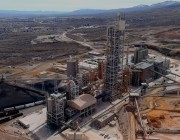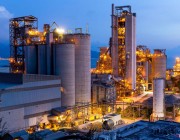The buildings and construction sectors are responsible for approximately 39% of global energy-related carbon emissions annually as of 2018, with 28% due to building operations (from energy needed to heat, cool, and power buildings) and the remaining 11% (referred to as “embodied carbon”) from the manufacture of building materials and products such as steel, cement, and aluminum, and the construction process itself. In the United States, the production of iron and steel, cement, and aluminum accounts for 7%, 6%, and 2% of carbon emissions, respectively, although the produced materials are used in many applications in addition to building construction. As aggressive codes push new buildings to meet zero-energy and zero-carbon targets in their operations, corresponding efforts to reduce embodied energy and carbon from building construction materials must be pursued to achieve building-sector decarbonization goals. Moreover, at the intersection of the buildings and industrial sectors, initiatives to decrease embodied carbon in building materials will increase demand for low-carbon products, thereby improving the business case for manufacturing industries that may be hesitant to enter this market.
The emerging interest in Buy Clean policies provides a prime opportunity to accelerate the reduction of embodied carbon in building materials and buildings systems. Since California’s Buy Clean bill (formally AB 262) was signed into law in 2017, related proposals have been introduced in six additional states, and the Biden Administration issued an Executive Order (EO14057) to spur green procurement policies across Federal Agencies. At the county and municipal levels, similar policies have been proposed or considered. However, these proposals have focused on a materials-based approach (i.e., specifying particular materials with low embodied carbon); they have not yet integrated perspectives on whole-building performance (e.g., selecting alternative materials, reducing waste, trade-offs between embodied carbon and operational carbon emissions). Equally important are complementary approaches to encourage the adoption of low-carbon product standards and design practices.
To accelerate the shift to low-embodied-carbon materials, ACEEE is working to employ building standards and codes that can complement Buy Clean procurement policies. Although environmental advocates and architectural pioneers have historically promoted zero-waste buildings, mainstream building design and construction practices, which are regulated by building codes, have remained largely unchanged. Building codes were originally designed to safeguard public health and safety. Separately, energy codes have traditionally focused on reducing the energy used in building operations while continuing to meet building function, safety, and comfort requirements. The selection of building materials and systems is largely unregulated as long as minimum health, safety, and performance standards are met. By setting minimum performance standards for a building’s life-cycle greenhouse gas emissions, building codes would provide clear market signals that manufacturers need to invest in long-term low-carbon processes, facilities, and technologies to meet emerging market demands.
One challenge of incorporating embodied carbon provisions into model building codes lies in the complexity of the codes-development process, which requires standardized methodologies at the national and international levels, robust technoeconomic analyses and modeling, and thorough evaluations of the codes’ impact on various stakeholder groups (including manufacturers, building owners and developers, builders, and occupants). In a recent study, ACEEE examined the current state of knowledge of embodied carbon in buildings through the lens of building codes and identified major knowledge gaps. ACEEE is strategically participating in multiple code and industry standard committees and working groups, building the necessary foundation to advance embodied carbon in model codes, and leading the effort to incorporate embodied carbon into comprehensive building decarbonization pathways. We support these efforts through our research into low-carbon materials, other sources of embodied carbon in building energy systems, and the interaction between energy-related emissions and those from other parts of the building life cycle.

In using building codes and standards to create market pull for low-embodied-carbon materials, ACEEE is working with the industrial sector to accomplish two main goals: (1) understand the challenges of reducing carbon emissions in product value chains and (2) lower the barriers for manufacturers to transform their business models. Support and participation from these manufacturers and their partners will be key to the success of measuring and reporting the carbon emissions of building materials and products. Data gathering and disclosure are essential to both producing low-embodied-carbon products and supporting specifiers and purchasers who want to select such products. Such efforts are part and parcel of our code and standard development and consensus-building activities.
While the current efforts of many organizations have been valuable in creating momentum, the multi-layered solutions that will ensure the success of policies like Buy Clean across complicated supply chains must be rigorously developed and tested; they must also be applicable to a dizzying array of products. Leveraging our decades of experience in working with and convening industry, ACEEE is collaborating with leading manufacturers and their trade associations to build business cases for reducing embodied carbon in building materials. These efforts will also increase the availability of low-embodied-carbon products and materials in related non-building markets such as transportation and infrastructure.
We anticipate the outcomes of our multi-year efforts will include creating a coalition of participating industry leaders that supports progress in embodied-carbon reporting and labeling; developing business cases for building materials manufacturers; improving coordination among standards-setting organizations, federal and international agencies, participating code officials, and other industrial companies; and developing policies that drive down emissions from the full building life cycle.
Embodied Carbon Workshop and Roundtable
at 2023 ACEEE Industrial Summer Study-
INTRODUCTION, KEYNOTE, AND ADDITIONAL MATERIALS
Embodied Carbon Workshop and Roundtable Brochure July 11, 2023
Introduction to ACEEE’s Industry Program (Nora Wang Esram – ACEEE)
Keynote Presentation: Opportunity to Decarbonize Industry through RDD&D (Joe Cresko - Department of Energy (DOE) Industrial Efficiency & Decarbonization Office (IEDO))
-
FEDERAL AND STATE PERSPECTIVES
IEDO’s strategy to decarbonize the cement and concrete industry (Isabelle Sgro Rojas – DOE IEDO)
Update on GSA’s “Buy Clean” Embodied Carbon Initiatives (Brad Nies – General Services Administration)
Interaction between Specifications and Pilots for New Concrete Technologies/NRRA (Maria Masten – Minnesota Department of Transportation)
Optimizing concrete mix designs for pilots (Leif Wathne – Iowa State University, National Concrete Pavement Technology Center)
-
INDUSTRY – NEW TECHNOLOGIES, PILOTS, AND OTHER KEY CONSIDERATIONS
New Low Carbon Concrete Materials Pilots (Lucas Moreno Kristiansen – Argos USA)
New Materials and Other Avenues to Reduce Embodied Carbon in Concrete (Zachary Grasley – Texas A&M University, OSL Concrete, Circle Concrete Tech)
Workforce Development – Role of IACs (Annick Anctil – Michigan State University Industrial Assessment Center, Institute of Public Utilities)
Philanthropic/Venture Capital Support for Emerging Clean Technologies (Abigail Regitsky – Breakthrough Energy)
-
BENCHMARKING CARBON INTENSITY, STANDARDS, TESTING, TEA, LCA, NEW METHODS
Infrastructure Materials Testing and Standardization Process (Aron Newman – National Institute of Standards and Technology, Low Carbon Cements and Concretes Consortium)
LCA/Clean Energy Renewables for Pilots (Xingang Zhao – Oak Ridge National Laboratory)
Early Product TEAs for Decision-making (Samantha Reese – National Renewable Energy Laboratory)
Benchmarking of Carbon Intensity/Performance Based Standards (Andrew Mullholland – Amcrete, ConcreteZero)
Resources






